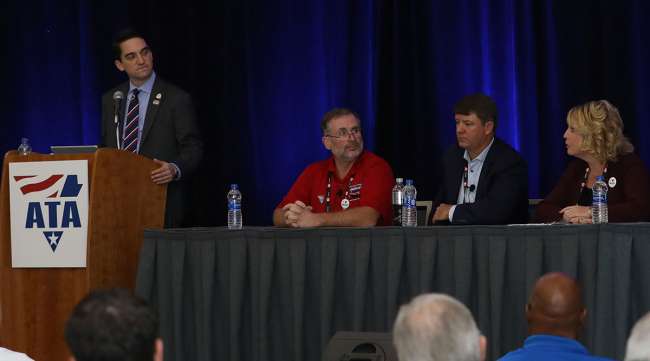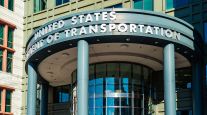Managing Editor, Features and Multimedia
Training Key for Smooth Transition From AOBRDs to ELDs

[Stay on top of transportation news: Get TTNews in your inbox.]
SAN DIEGO — As the trucking industry completes its transition to federally mandated electronic logging devices, motor carriers should not underestimate the amount of planning and training needed to ensure a smooth rollout, industry experts said.
The federal ELD rule will go into full effect Dec. 16, when a two-year exemption for e-log systems known as automatic onboard recording devices, or AOBRDs, is set to expire.
Fleets that still are using grandfathered AOBRDs to record drivers’ hours-of-service data have until that deadline to update their onboard technology to compliant ELDs.
But making that change isn’t as simple as it might seem, panelists said during an Oct. 6 session here at American Trucking Associations’ Management Conference & Exhibition.
“There’s a lot of planning to do, and it takes time,” said Lisa Gonnerman, vice president of safety and security at Transport America.
The company began converting its fleet of about 1,700 trucks from AOBRDs to ELDs earlier this year and has nearly completed that transition, she said.
Transport America’s Gonnerman says malfunctions and diagnostic events are probably the biggest challenge with #ELDs her fleet is currently encountering. #ATAmce19 pic.twitter.com/6rCpm8y0Ot — Seth Clevenger (@SethClevenger) October 6, 2019
To ease that process, Transport America provided about an hour of face-to-face ELD training for each driver.
However, the switch to ELDs also involves significant changes in the back office that require training for operations staff, as well as changes to company policies to handle details such as how to accept or reject log edits.
“It seems like it’s a pretty easy transition, but there are key changes that really did bring a lot of questions,” Gonnerman said.
One key question for fleets is how to manage the use of their vehicles for yard moves — which can be recorded as on-duty, not driving time — and personal conveyance while the driver is off-duty.
Transport America, for one, has not allowed yard moves, but does allow some personal conveyance, although the back-office auditing of those miles is “very challenging,” Gonnerman said.
Technical issues with ELDs also present problems. Today, malfunctions and diagnostic events probably are Transport America’s top challenge with ELDs, she said.
Jim Mullen, chief council at Federal Motor Carrier Safety Administration, said it’s unclear exactly how many motor carriers still need to make the move from AOBRDs to ELDs.
“We don’t really have a good feel, quite candidly,” he said.
Mullen took an informal poll of the carriers attending the session, which indicated that a majority had made the change.
ODFL’s Goins says #ELDs have eased roadside inspections. “It has sped up the process, simplified the process.” #ATAmce19 pic.twitter.com/kmXj9avtMx — Seth Clevenger (@SethClevenger) October 6, 2019
The transition to ELDs ultimately will streamline inspections, he said. “The transmission of the data electronically at roadside will make things more efficient and faster, which is good for law enforcement, good for the driver, good for everybody.”
Bill Goins, a professional driver at Old Dominion Freight Line and an America’s Road Team captain, has moved from paper logs to AOBRD and now ELD during his career.
The switch to electronic logs has simplified the job by eliminating the paperwork associated with traditional paper logs, he said. “At the end of the day, I don’t have to sit down with the fine-point pen and a ruler and a calculator before I can go to bed.”
ELDs also remove the option of fudging a paper logbook to “just make it happen,” Goins added. “I’m glad that’s off the table.”
Goins said initially he was skeptical of e-logs but now appreciates the technology.
“As a driver, it’s simplified my day, simplified my job,” he said. “I actually like it.”
Most interstate motor carriers have been required to use either ELDs or AOBRDs instead of paper logbooks since December 2017, when the ELD rule first took effect.
In a speech at MCE a day earlier, FMCSA Administrator Ray Martinez said the ELD mandate has improved compliance with federal hours-of-service limits.
“The preliminary information indicates that ELDs are, in fact, reducing driver fatigue, and I believe that they continue to hold the potential for greatly improving safety,” he said.
Martinez also acknowledged that the industry’s transition to ELDs is not complete. He urged carriers that still are running AOBRDs to make the switch to ELDs without delay.
“The deadline is approaching quickly,” Martinez said. “I ask you to please do that as soon as possible, and don’t wait until the last minute.”
Want more news? Listen to today's daily briefing:





